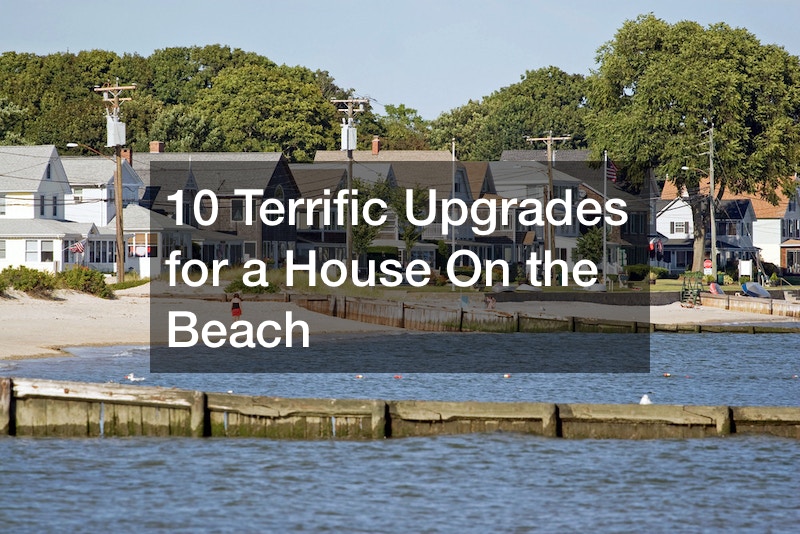Our website may receive compensation from partner links and videos placed in our content.
We are not experts in any particular field. Our content is written by those interested in the various topics, not by professionals. All content is intended to be informational and should not take the place of professional advice. Before making any decisions that could be life altering, please consult with a professional in the field.
Waterfront homes are already pretty terrific by themselves, but chances are, they could be even more awesome. Whether for family vacations or renting out, there are a few ideas worth considering to make it an everyday paradise. Maybe something as simple as installing an outdoor shower, or as consuming as constructing a dock for a boat. Perhaps a new weatherproof coat of paint? Below are some of the best upgrades for a house on the beach, ranging from pleasurable upgrades to sensible improvements. Let’s begin.
1. Buy New Windows

With such a to-die-for view, it would be a shame if your windows didn’t do it justice. However, you also need security against the elements. Between the moisture-heavy air, saltwater corrosion, intense sunlight, and strong winds, your windows must be as weatherproof as possible. Professional window installers in your area should be able to advise you on the best upgrades for a house window. Some of the factors you ought to take into account include:
- Impact Resistance Glass – install impact-rated glass that can withstand a windstorm’s forceful winds. Alternatively, you may install DP-50 windows (basic protection) and then reinforce the opening with storm protection in order to meet impact resistance ratings. With the former option, you won’t have to install plywood panels or shutter up in preparation for a coming storm.
- Energy Efficiency – use a Low-E glass to reduce the amount of heat that can flow through the glass. In addition, look for Energy Star and NFRC labels that indicate energy efficiency. The NFRC label will show values such as the U-Factor (how well the window keeps heat in), Solar heat gain coefficient (how well a window resists heat gain), visible transmittance (how well light transmits in), and air leakage(a lower the figure equals fewer drafts).
- Warranty – look for a non-prorated and fully transferable 20-year warranty on the glass. For the non-glass parts, get a warranty that’s at least ten years. These kinds of solid warranties are mostly offered by larger companies.
Robust laminated coastal windows have added benefits such as better security since they are much harder to break. This is an important benefit for homes that won’t be occupied for much of the year. Other benefits include sound dampening and UV protection. As for the window frame, fiberglass is an extremely sturdy and robust option that will work superbly in extreme coastal conditions. However, they are expensive, so you may want to consider aluminum or vinyl frames. Wood is also an option though it will require serious maintenance. Available window types include wide opening casement, secure awning, alternative hopper, sliding sash, single hung, double hung, and a perfect picture window.
2. Renovate Your Bathroom
The bathroom is one of the most enjoyable rooms of any house, so why not make it a priority in yours? Imagine slipping into a jet tub after a long day on the beach or, even better, one that overlooks the ocean. Adding a window will also reduce the chances of mold through better ventilation. How about calling custom glass shower contractors to upgrade your shower setup with beachy blue glazed subway tile and brand-new fittings? Install floating vanities to open up the space. Don’t forget storage either, and perhaps a chandelier and music system for some glamour and pizzazz. Additionally, consider your daily routine and organize the layout based on that. Add double sinks if multiple people will be using the bathroom. Another valuable addition would be a two-inch drain pipe, which will reduce the chances of clogs.
According to HomeGuide, the average cost of renovating a bathroom is $2,000 to $5,000, depending on the project’s scope. Before you begin your bathroom remodel, plan carefully and research the possible costs. Otherwise, you risk turning your renovation into a full-on remodel that will cost you $5,500 to $15,000 on average. For a master bathroom, the costs are even higher at 10,000 – $30,000 on average. According to Remodeling Magazine’s 2021 cost vs. value report, a midrange bathroom remodel will have an average ROI of 60.1%. Consider what you hope to get from your remodel to avoid disappointment.
3. Invest in Your Interior

Many homeowners find themselves blowing past their expected budgets when it comes to renovations. You can reduce the shocks of this by adding a 20% buffer to your budget and one for the timeline. In addition, not all changes have to be so drastic. If you already love the space you are in, then less dramatic but still very impactful changes may do. Examples include mood lighting, colorful mobile wallpaper, new chill cushions, or a new coat of paint. How about the gadgets in the house?
You could run your entire beach home through a smart hub like Amazon’s Echo Dot. Upgrade your home theater system installation and use the smart hub to stream music via your preferred service. For peace of mind while you are away, invest in smart locks and cameras so you are always aware of what’s happening on your property. There are many more smart gadgets, e.g., thermostats, robot vacuums, and motion-activated lights, that can liven up your home. Sometimes the simplest additions are the best upgrades for a house. Alternatively, you could go big and remodel the whole house. According to HomeGuide, the average cost to do so would be $19,800 to $73,200 or $15 to $60 per square foot.
4. Replace Your Electrical System Components
If your home is 30 years old or more, have a licensed electrician inspect your wiring. They will ensure that your wiring is safe and up to code. This is one of the best upgrades for a house since it could save your home by the beach. Or even your life. Many homes built between 1965 and 1973 used aluminum electrical wiring due to its affordability. However, copper is more stable, durable, and performs better. Besides the danger posed to the house and human life, an old malfunctioning electrical system also shortens your appliances’ lifespan. Here are some warning signs you can look out for that indicate you need professional help:
- Breakers trip frequently
- Frequently blown fuses. Fuses are older systems designed to handle lesser electrical loads. Ideally, you should get an electrical panel replacement
- Lights dim and flicker repeatedly
- Sparking, warm, or discolored outlets
- The smell of burning wires/appliances
- Tingling/shocks when you touch an appliance
- A lack of Ground Fault Circuit Interrupter (GFCI) outlets in the house’s rooms
- You resort to extension cables often, meaning you need more convenient outlets
5. Install a Tankless Water Heater

Tankless water heaters provide hot water as soon as needed, and thanks to their design, they don’t have the kind of standby energy losses associated with storage water heaters. According to the department of energy, tankless/demand-type water heaters can be 24 to 34 percent more efficient in homes that use less than 42 gallons of hot water a day. Even homes that use around double that amount are 8 to 14 percent more energy efficient. Moreover, tankless water heaters are more durable, lasting for 20 years as opposed to storage versions that last for 10-15 years.
These become one of the best upgrades for a house on the beach when you consider that they take up less space, require less maintenance, and provide you with endless hot water. However, their output is limited in that if you are running a shower and dishwasher simultaneously, the device may be unable to keep up. Your plumbing service may advise installing two or more tankless heaters to compensate for the limited output. The average cost of a gas-powered tankless water heater is $1,000 to $1,500, while that of electric-powered models ranges from $500 to $1,500. Installation for both hovers around the $1,000 to $1,500 mark.
6. Switch to LED lighting to Conserve Energy
According to the department of energy, lighting accounts for 15% of an average household’s electricity usage. By using LED lighting, the average home can save $225 annually. And you don’t have to let go of the warm, yellow hues of incandescent bulbs. There are LED bulbs with dimming features that produce a similar glow. LEDs also offer versatile custom lighting options, allowing you to light under cabinets, make your kitchen glow like a starry sky, create a romantic mood for your bedroom, or accent your stairs beautifully. The endless options make it one of the simplest and best upgrades for a house.
7. Improve the Home’s Insulation

As mentioned earlier, beach homes face harsh weather and highly humid conditions. Closed cell insulation is the best insulation solution and one of the best upgrades for a house to seal out moisture and create a pleasant internal environment. It is a highly dense spray polyurethane foam (SPF) insulation which makes it an excellent barrier against water vapor, air, and sound. Closed cell insulation provides up to 98% heat reduction compared to traditional fiberglass at 35%. Not only is the material suitable for insulation, but there are also SPF roofing systems with a lifespan of more than 20 years. According to Home Advisor, the average cost to install spray foam roofing is $11,000 for a moderate double-layered installation using medium-density foam.
8. Invest in New Fences
Maintaining privacy and protecting your beach home are some of the best upgrades for a house. They are essential to you enjoying your property. But what fence can stand up to the salt, water, wind, and sand? Woods such as cedar and redwood have natural moisture resistance, but even they must be stained or repainted regularly if they are to last. Most metal will rust. So what is the best option? Fence companies agree that aluminum and high-quality vinyl fencing are excellent materials for coastal fencing. According to lawnstarter, an aluminum fence costs $48 per linear foot, while a vinyl fence costs $28 per linear foot.
9. Update Your Exterior Walkways

From stone steps to flagstone to pavers to wooden walkways, you have many options for sprucing up the exterior. The ideal walkway will lead into the beach seamlessly while not being a distraction from all the natural beauty around you. According to HomeGuide, a paving contractor will charge $10 to $17 per square foot to install pavers, while materials like bluestone would cost you $17 to $25 per square foot. Whichever choice you feel is right, do your research before hiring a professional to get a job done right the first time.
10. Beautify Your Exterior With Landscaping
When landscaping near the beach, use salt-tolerant plants such as the beach rose with its pink or white flowers, ivy geraniums, and lantana, or go native with options like woolly beach heather or beach grass. Consult the USDA plant hardiness zone map to determine which plants are more likely to thrive in your area. However, if you feel unsure about how best to beautify your yard, hire a landscape designer. They are well versed in all the options available to you. If you want your backyard pool bordered by an assortment of tropical shrubs, trees, and plants, they can bring that dream to life. However, look to work with designers or companies that are members of a state or national association. Look at the work they have done before and their years of experience. If you want the best upgrades for a house possible, do your homework and peruse the contract offered carefully.
Lastly, ensure that all contractors you hire to install the best upgrades for a house are licensed and insured. The insurance protects you from liability in case of damages or accidents while on the job. Also, have everything put down in writing before work starts. You need to be appraised of every step in the process, so a lack of transparency is a red flag.


